What to do, see and eat in Vienna
Vienna is certainly one of the most beautiful cities we have had the fortune to be able to explore in detail. This is a recap of what we thought were the best things to do in Vienna during our 5-day trip. This post will give you some ideas of what to do, see and eat while visiting Vienna.
Vienna is the capital city of Austria built on the Danube, like the neighboring Bratislava in Slovakia and further down, Budapest in Hungary.
Discarding our travel time we only had a total of four days to explore Vienna and Bratislava (where we took a day trip from Vienna), but despite that, we still managed to see a fair amount of the city’s spectacular buildings and sights.
Still, do forgive us if we have left something significant out – there is only so much you can do in a few days.
How to get from the airport to Vienna city center?
There are of course many ways to travel to Vienna, by road, plane, rail or even boat. If you arrive by train you will be centrally placed near the wonderful public transport system that covers pretty much the whole city. It really is fantastic and easy to get around once you work out how it all functions.
We arrived at Vienna International Airport without a concrete plan how to get into the center of town. We had nearly pre-booked a taxi but then thought we would play it by ear when we got there. As it turned out this was a much better idea, to use the fantastic public transport system.
We spoke to the woman at the information desk at the airport and were given perfect instructions on how to get into town. Basically we just hopped onto the S7 (S-bahn) train line run by ÖBB which took us directly to Wien Praterstern, in about 27 minutes, which was a 5 minute walk from where we were staying.
If you need to get anywhere else in the city you just jump off at one of the other stations and get onto the underground system (U-bahn – U1-U4) which traverses the city, or use any one of the bus (autobus) or trams (Straßenbahn) to get to where you want to go – it really is quite simple!
The best way to plan your individual trip is, of course, to use Google maps, which will give you the exact route alternatives, times and numbers of the vehicles you need to catch.
You can buy the tickets in a machine in the station and we paid 6,30 Euro for 2 adults and a 9 year old child for a one way ticket from the airport to the city center. Quite a bit cheaper, and quicker, than a taxi ride.
The great thing about traveling on the public transport system in Vienna is that it is wholly owned and run by the state. Everything is spotlessly clean, new and runs on time, so you do not have to build in extra time to get anywhere.
You can pretty much rely on the bus or train turning up on time. And if there is any delay it will tell you when it will be arriving.
Vienna City Card – flexible travel on public transport
We had very kindly been given the city cards from the Vienna Tourist Board for our stay. The Vienna City Cards are valid for either 24, 48 or 72 hours which gives you free transport on all the public transport in the city. It also gave us discounts to many of the sights we visited, museums and the like, many of which did require some kind of entrance fee.
We would definitely recommend getting one of these cards which gives you total flexibility of travel and are probably at the end of the day cheaper than buying individual tickets for every journey, especially considering the discounts you get.
The Vienna City Cards work for the trains, trams, buses and the underground and you only have to validate once at the beginning of your journey.
Click here to get your Vienna City Cards!
Things to do in Vienna
Vienna the City of Music
Vienna’s history is famous for being a city where some of the most famous musicians have made their names in the past, especially the classic composers.
We are talking of course about, among others; Johann Strauss I and II, Schubert, Haydn, Beethoven, Salieri, Liszt, Brahms and last but not least, my favorite, and in my eyes THE most incredible classical composer ever, Wolfgang Amadeus Mozart.
Mozart died too young at the age of 35 in Vienna in 1791 after writing a huge amount of music, most of it brilliant. Think of him or listen to his music as you explore this famous city.A few of my recommendations will give a real feel of just how important Vienna and its musicians were for the history of music.
-
Watch a classical concert

Classic Ensemble at the St. peter’s Church in Vienna.
While you are in Vienna there are many places where you can enjoy a classical concert and take in some of the traditional culture of the city. The Vienna Ticket Office is a good start as it will show you what is on and you can choose something to suit your budget.
Whether it is the State Opera or the Vienna Philharmonic you wish to see, you will be able to plan it there. You may find some of the tickets quite expensive but they are in high demand and you had better book up front if you want to have tickets.
Perhaps you are there at the right time to take in a Vienna Philharmonic summer concert at the Schönbrunn Palace, or a New Year’s concert (Neujahrskonzert Wien) in the Musikverein? Whichever it is, you may have to dress suitably.
We were actually fortunate enough to get tickets to see a variety of music from Mozart, Vivaldi, Schubert, Bach, Dvorak and Strauss performed at the St. Peter’s Church one evening by a wonderful string quartet.
The Classic Ensemble was really a splendid thing to do and highly recommended.

The quartet getting ready to play. Enjoying classic music is one of the best things to do in Vienna.
The city really is a hive of musical activity, and you will notice many people walking through the center carrying instrument cases.
A night at the Vienna State Opera?
I suppose if you have recently won the lottery you could consider getting tickets for the opera. Unfortunately our lottery ticket was again a loser last month so we did not manage it. But what an experience that must be to see Madam Butterfly or the Marriage of Figaro in the Opera House in Vienna! A dream come true.
We would hardly be properly dressed for it as well I suppose, thanks to Ryanair’s carry on baggage restrictions – I am sure they must have a fairly strict dress code. Not sure our walking boots would qualify!
But don’t feel like you have to spend hundreds of euros to enjoy classical music in Vienna. Like we mentioned above the Classic Ensemble was amazing to see and the acoustics in the church will leave you filled with amusement at the performance. And above all, it was affordable!
Here are other affordable performances:
-
Haus der Musik
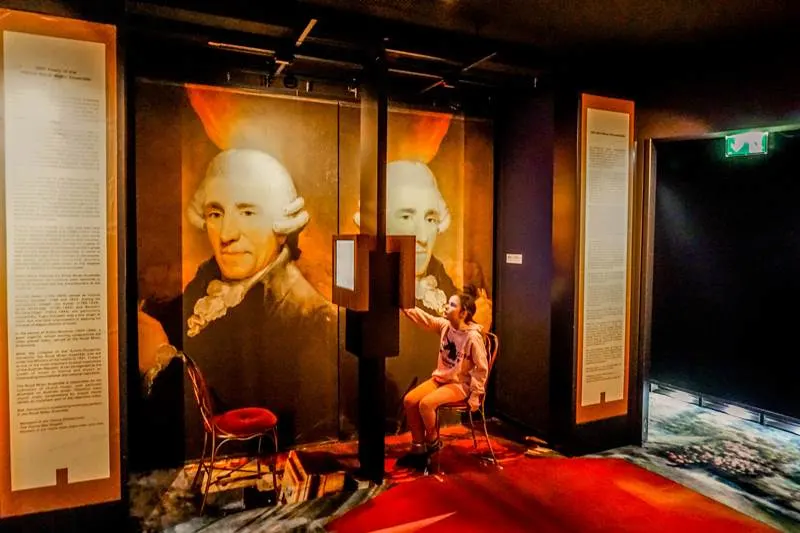
Learn about all the great composers at the House of Music.
Perhaps if you do not have time to see the Vienna Philharmonic themselves a trip to the Haus der Musik is an easy alternative. This lovely museum is great for adults and kids alike and has 4 floors of interactive musical entertainment which is fascinating.
You can attempt to conduct the Vienna Philharmonic yourself (and get ready for some rebuke from the orchestra when you do it wrong, lol), or compose your own waltz. There is a computer program that will turn your name into a fragment of music in Mozart’s hand and will play it back to you.
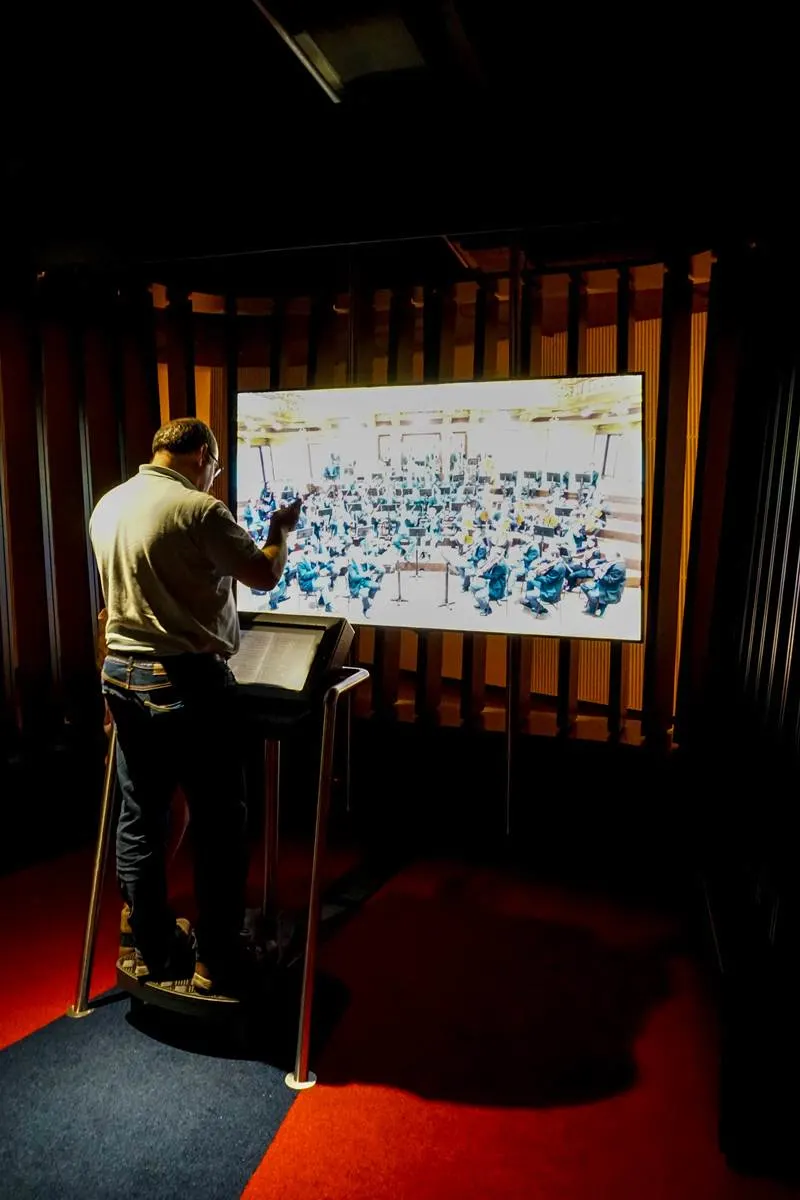
Conducting the Philharmonic at the Haus der Musik.
There is a theater where you can listen to an hour’s recordings of the Vienna Philharmonic in different situations. One floor is dedicated to the great composers and tells you a bit more about their lives. Another floor teaches about the qualities of sound and different instrument types.
All in all a very interesting and instructive museum, which may persuade you to buy some concert tickets anyway! Go see it!
-
Visit some Churches
Though we are not particularly religious, whilst we were in Vienna we visited a few churches, and all of them were completely stunning. There are many beautiful churches in Vienna and it would not have been possible for us to visit them all in the time we had, as we had other venues on our list.
Here are some of our highlights:
Karlskirche (St. Charles Church), Vienna
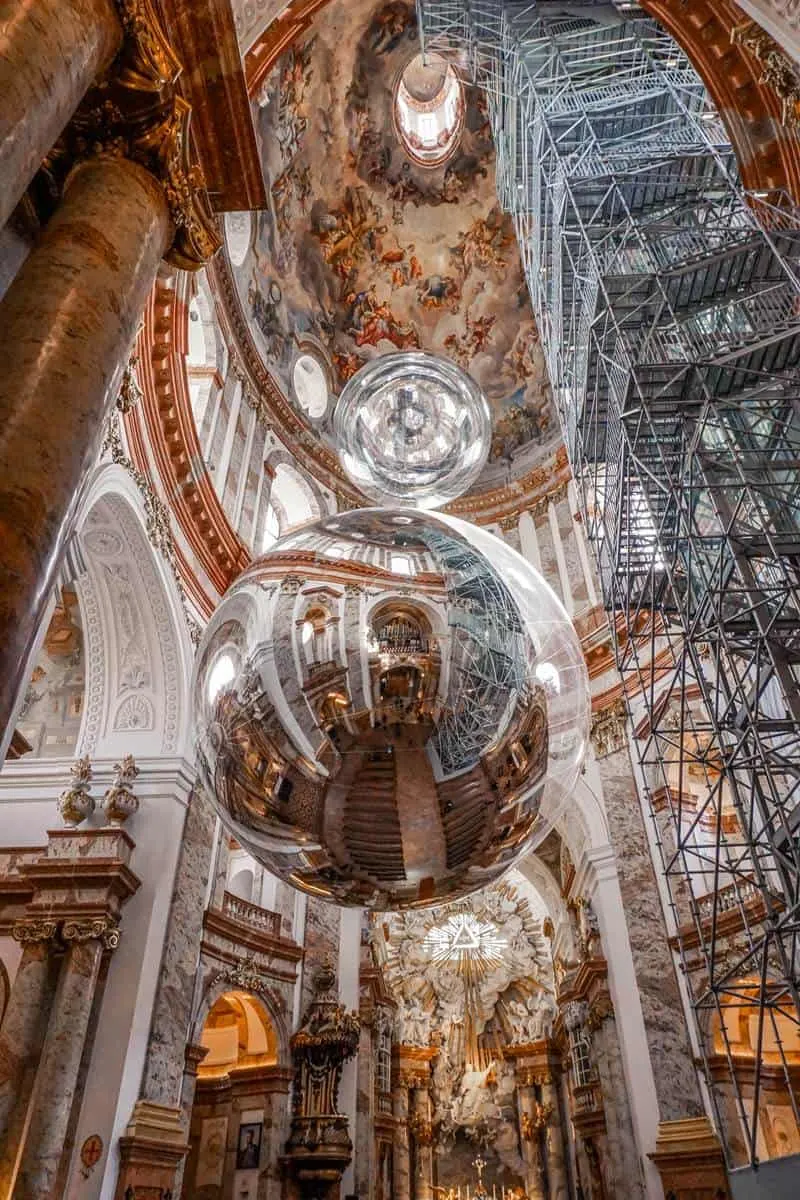
Karls Kirche interior and lift to the dome.
Probably the biggest highlight for us was the Karls Kirche (Charles Church). This church was built under the orders of Emperor Charles VI in honor of the sufferers of the plague of 1713/14, which had killed more than 8000 people in the city. The Church was named after the saint of plague sufferers, St. Charles Borromeo.

Frescos at the Charles Church.
The construction started in 1716 and was finished in 1737. What is so striking about this church is the beauty inside, with wonderful frescos on the inner dome and other parts of the church. When we went there was a lift present inside the church which was installed for renovation of the frescos in 2000.
You can still access the platform at the top to the side window of the church for views of the city or get close up views of the frescos from the top of this lift. Really quite stunning and worth the discounted 10 euro fee to get to the top.
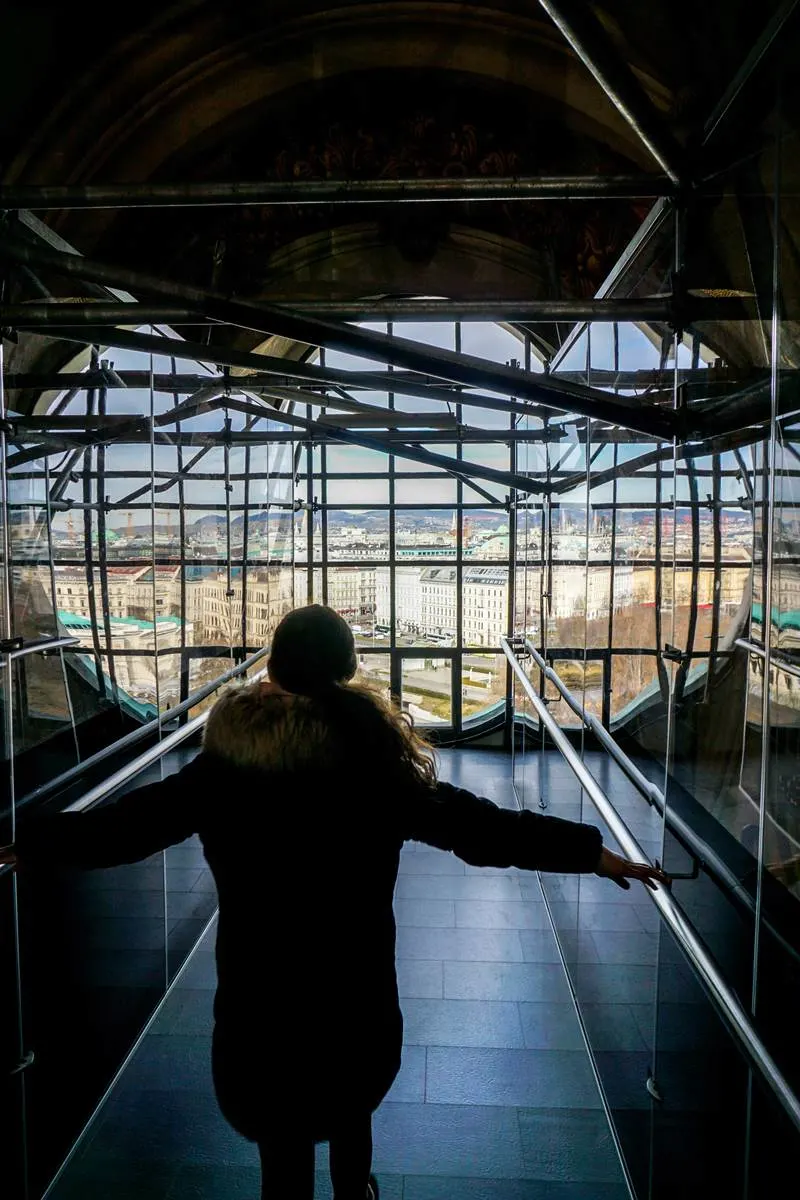
Viewing platform at Karlskirche, Vienna.
The rest of the building is just amazing and you can also climb the circular staircase near the entrance to a treasure room containing some original pope’s garments and some jewel encrusted golden religious ornaments.
St. Peter’s Church, Vienna

St. Peter’s Church.
This is the church where we saw the Classic Ensemble Vienna play. The original church at this location is thought to date back to the latter half of the fourth century, making it one of the oldest churches in Vienna.
But this church was rebuilt after Emperor Leopold had vowed to do so after the plague of 1679/80. This church was not finished until 1733.
So it would seem that the plagues that were commonly around in those days certainly helped contribute to producing some of the fantastic memorial churches for this city.
Votivkirche, Vienna

Votive Church (Votivkirche) in Vienna
This striking neo-Gothic style church took our attention from a distance so we had to take a detour and go and visit. Construction started in 1856 and the building was completed in 1879.
It is striking because of the two impressive spires and the patterned tiles on the roof, the latter similar to the St. Stephens Cathedral. Also it was built with sandstone, which is rather maintenance intensive, meaning it is constantly under renovation (also the case when we visited).
St. Stephen’s Cathedral (Stephansdom), Vienna
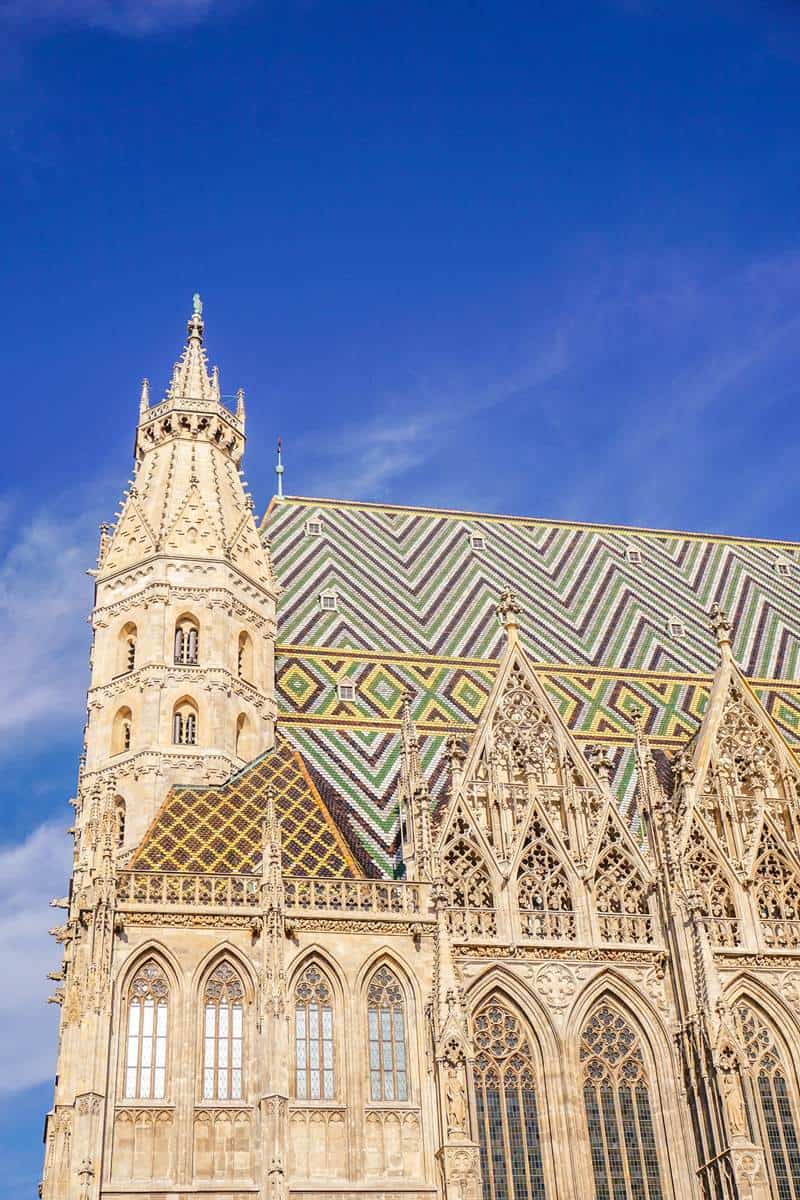
St. Stephen’s Cathedral.
This church is similar to the Votivkirche in that it has a beautiful colored tiled roof, but it only has one major spire. It is also a lot older. The original church dates back to 1147, but the main construction and expansion of the church carried on up to 1511 and repair and reconstruction has been going on ever since.
It is the most important religious building and one of Vienna’s landmarks, it has taken part in many important events in Hapsburg and Austrian history.
-
Watch the Lippizaners at the Spanish Riding School
If you are a horsey fan then really I suppose you have to go and see the Spanish Riding school in Vienna where they train the amazing Lippizaner horses. These horses originate in Lipica in Slovenia and are from the oldest continually working stud farm in the world.
The Spanish Riding School is located at the Hofburg in Vienna and it is where these beautiful white stallions are trained to perform classical dressage.
We did not have time in our itinerary to visit unfortunately, but do not let us dissuade you from going to see these magnificent skillful beasts in action.
-
Visit Schönbrunn Palace
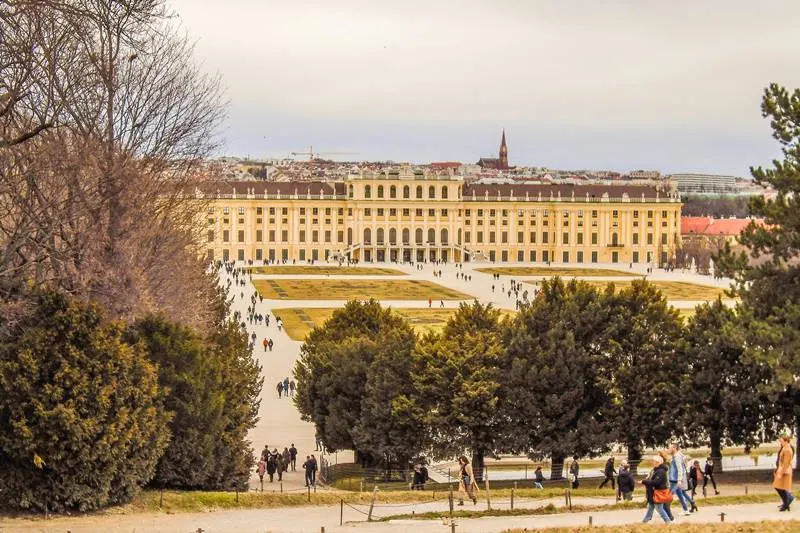
Schönbrunn Palace and gardens.
If you take the U-bahn to Hietzing or Schönbrunn you can go and visit the Schönbrunn Schlosspark (Schönbrunn Palace), a splendid 1440 room 17th century building, once the main Summer residence of the Habsburg rulers.
This magnificent park is now free to walk around and you could easily spend an entire day here exploring. There are tours around the Palace and concerts given there, and the grounds have wonderful gardens making it quite majestic, even in winter time.
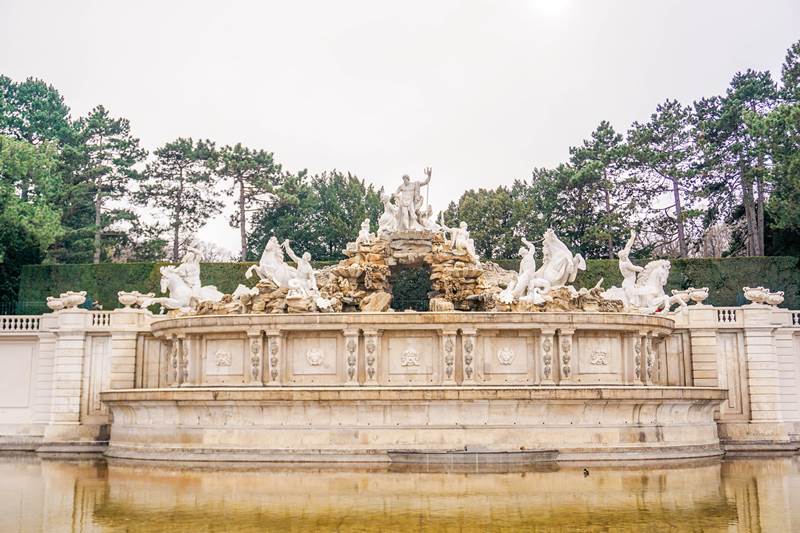
Neptune fountain at Schönbrunn.
There are several other interesting things dotted around the park, such as a maze and labyrinth area (which was closed when we visited), an old fashioned greenhouse (Palm House) and desert house (Wüstenhaus), the Neptune and Obelisk Fountains, Roman Ruins, the Wagenburg Museum, an Orangery and the Zoo (claiming to be the oldest in the world) that is a great attraction if you are visiting Vienna with kids.
You will also find in the grounds the Gloriette (1775) perched on the top of a 60m hill overlooking the Palace and the gardens. The Gloriette has a café inside and a wonderful view down to the Palace. And there are also 32 different sculptures dotted around the place.

The Gloriette.
Every year a summer night concert Schönbrunn is held in the grounds which must be just wonderful.
On a Sunday the gardens are busy with runners and joggers moving along the gritted paths, or couples walking romantically together as well as the ubiquitous tourist.
We spent half a day here and loved it. Highly recommended and entrance to the grounds is free of charge.
-
Visit Belvedere Palace and art museums
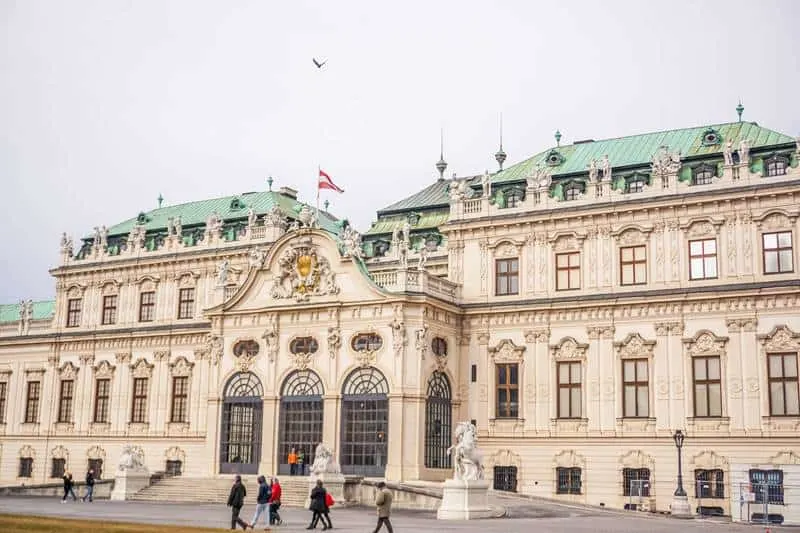
Belvedere Palace.
Next to the stop Wien Quartier Belvedere you can find this other amazing 18th Century Palace which houses some famous art collections.
At the beginning of the 20th Century Belvedere was the residence of the heir to the Austrian-Hungarian throne, Franz Ferdinand, whose assassination in Sarajevo was the cause of WWI.
There are two palaces the Upper and Lower Belvedere with some beautiful gardens in between. In the adjoining park there is the Belvedere 21, which houses contemporary art.
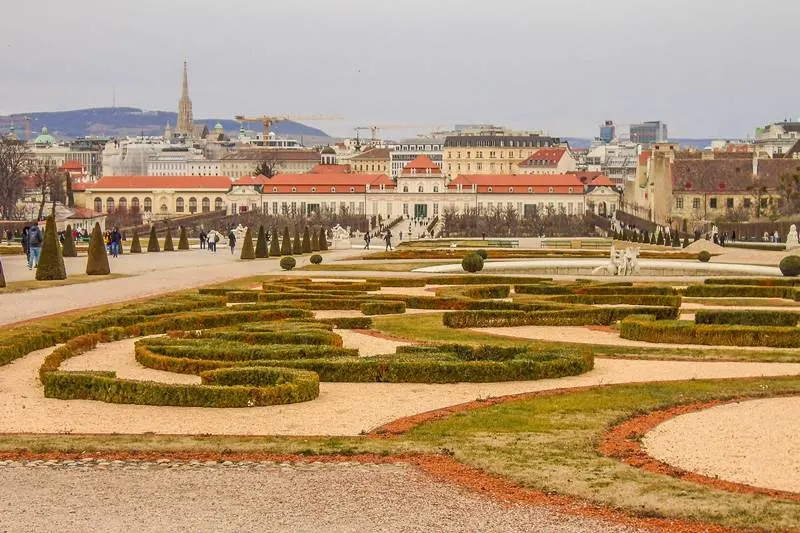
Belvedere gardens.
Upper Belvedere houses a permanent art collection which includes art from artists such as Gustave Klimt (the Kiss) and Franz Xaver Messerschmidt among others.
Belvedere Palace used to house the painting ‘Portrait of Adele Bloch-Bauer’ (1907) or the ‘Woman in Gold’ as described in the movie of 2015, which describes how the painting was repossessed by the niece of the owner after it had been stolen by the Nazis in 1941. The painting now hangs in the Neue Galerie in New York.
Both palaces have visiting Exhibitions from all periods. Belvedere is definitely also worth a visit. Entrance to the grounds is free of charge.
-
Skating at the Rathausplatz (Wiener Eistraum)
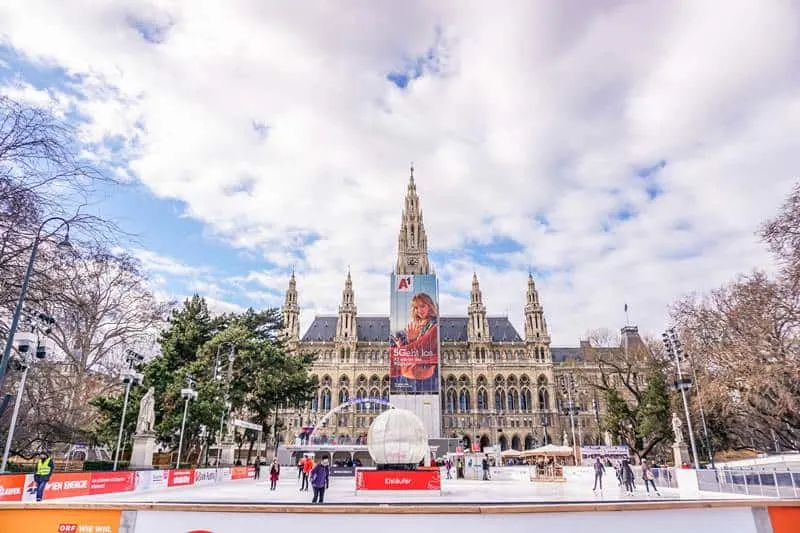
Wiener Eistraum.
In front of the Rathaus there is a wonderful ice rink that is open from January until March, 10 am until 10 pm. If your visit is outside of these months you will miss it, I would recommend doing something around the Danube river otherwise.
We have skated in many cities around the world in the winter time including places in Finland, Netherlands, German, Estonia, Poland and Portugal just to name but a few. But Vienna takes the biscuit.
The Wiener Eistraum takes up 9,000 m2 in the Rathauspark and has different levels so you can even skate downhill (and up!).
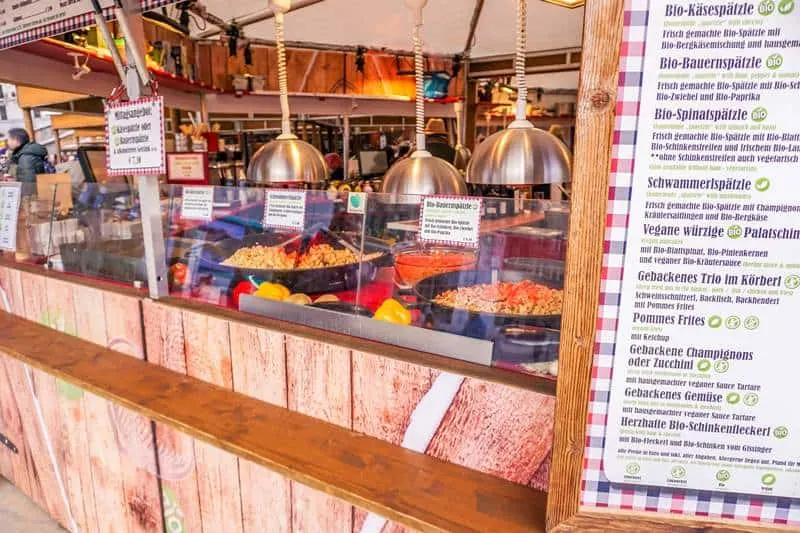
Food stands in front of Vienna Rathaus.
There is of course the necessary refreshments area where you can enjoy some local specialties like a glüwein, a traditional Austrian sausage in a hot dog, some spätzle (like a local pasta) or gebackene mäuse (does not translate well in Google translate, lol). Gebackene mäuse are similar to a Dutch oliebal – basically fried dough with different fillings.
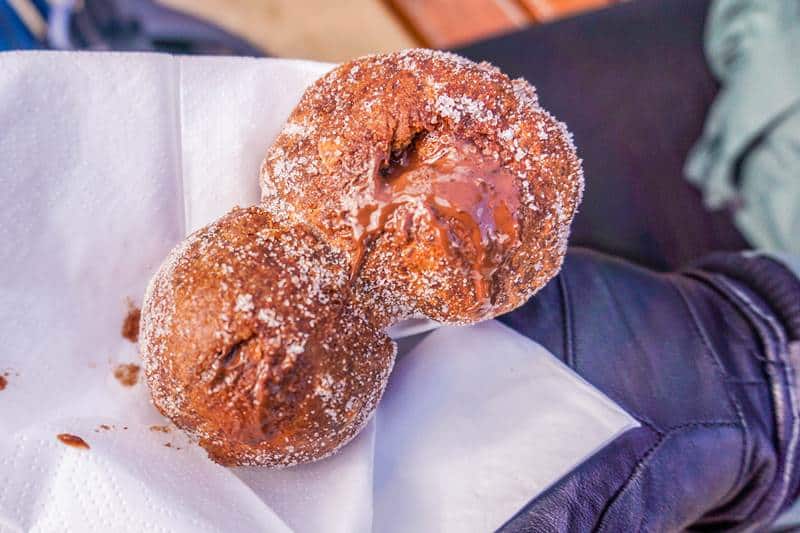
Gebackene mäuse filled with nutella.
If you are into skating, visiting here is a definite must do. And if not, just visit to experience the Austrian gemütlichkeit (warmth and good cheer).
If you have kids with you they will love it (in our case it was yet again ‘the best holiday she had ever been on’, thanks again Wiener Eistraum!).
-
Visit the Natural History Museum
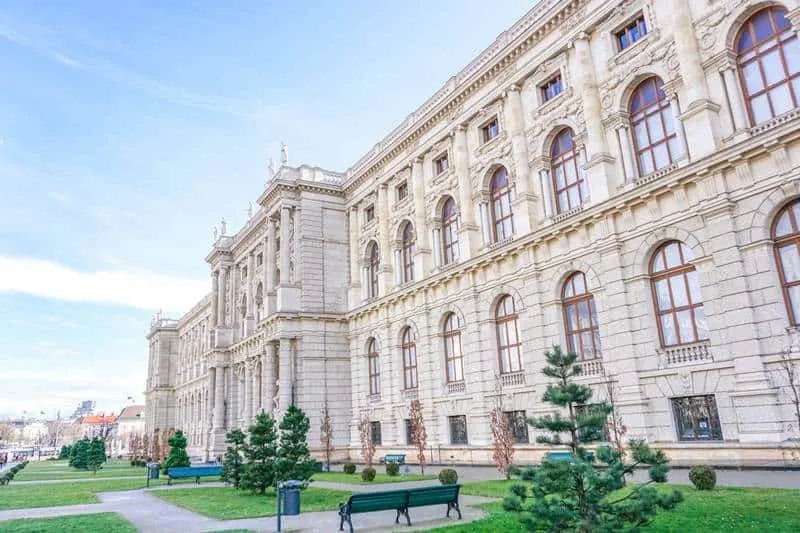
The Natural History Museum in Vienna.
The Natural History Museum in Vienna is another jewel worth visiting. It is located across Maria-Theresien-Platz opposite the Fine arts Museum and next to the Volksgarten, which is another park open to the public.
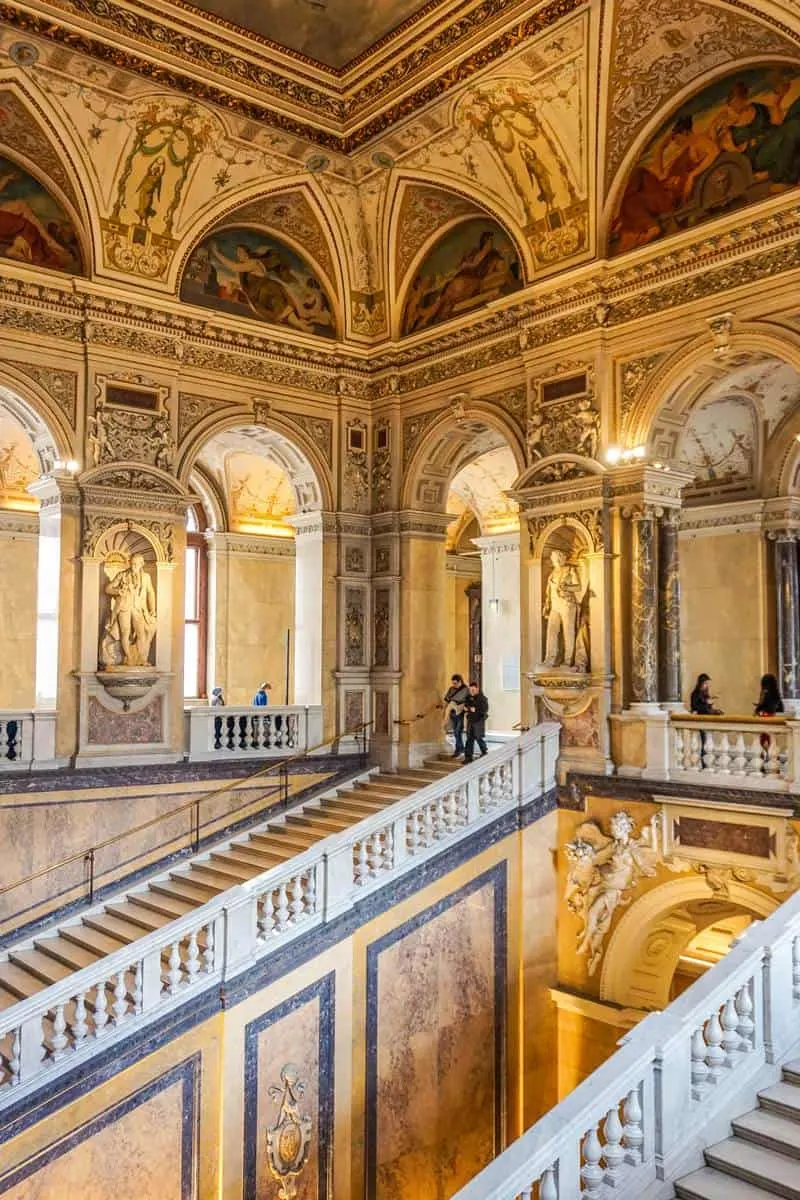
The interior at Vienna’s museum of Natural History.
The Museum houses a wonderful authentic collection on two floors of rocks, minerals, fossils, stuffed animals and skeletons and is really a quite remarkable building. As you walk in you are taken back by the staircase and wonderfully painted frescos and arches.
Beware as the cafe/restaurant on the second floor is quite expensive – ask for the menu before you order.
-
Wiener Prater
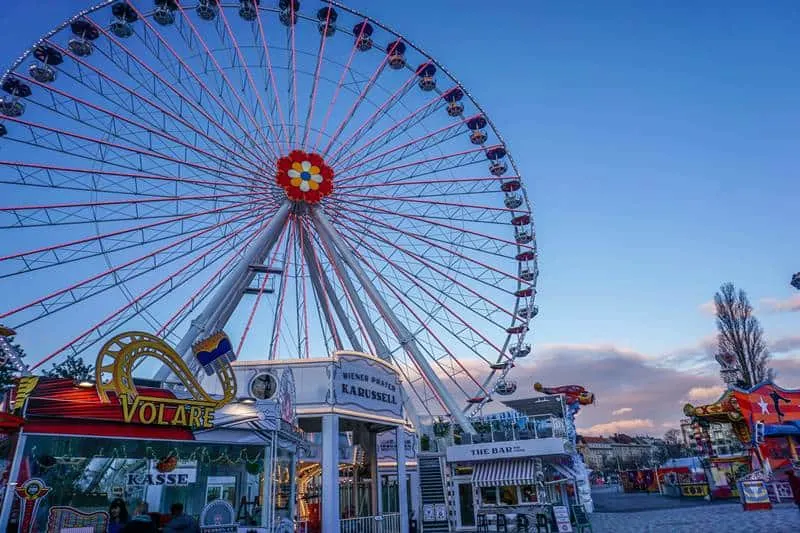
Wiener Prater is a large area with many attractions in Vienna’s second district.
The Wiener Prater is situated in a large park in the Leopoldstadt district of Vienna. It is an amusement park that has been there for quite a while. Mozart visited with his wife shortly before he died in 1791, and the park has been free to the public since 1766.
It was very close to our hotel, the Ibis Budget Wien Mess, so we had to go and pay it a visit.
The amazing thing is that it is open 24/7. You can just walk around and explore the different attractions. We were there in February and not all the attractions were open, but many seemed to be.
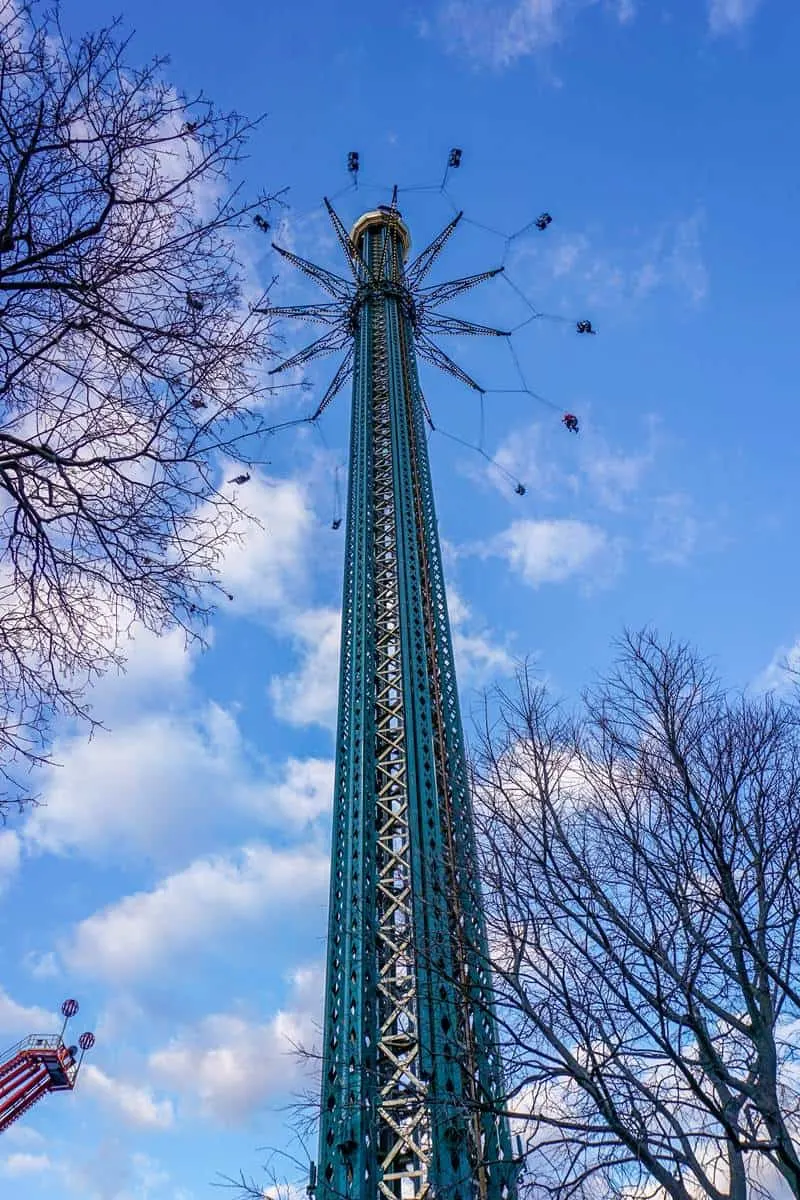
There are hundreds of attractions at the Vienna Prater.
Some of them were a little bit too scary for us but for fearless people there is plenty to try. You pay per attraction you go on, so you can control your budget. There are also arcades, dodgems, restaurants, railways, rollercoasters and even an indoor skydiving activity. The giant Ferris wheel is a landmark in Vienna, you can get skip the line tickets here.
Great for kids and worth a visit, but take your wallet.
-
The Hofburg Complex

The Hofburg (an area with a large complex of important buildings).
The Hofburg was previously the main imperial palace of the Habsburg dynasty rulers and is now where the President of Austria resides.
It dates back to the 13th century and has been expanded over the years to include the imperial library, treasury, the Burgtheater and the Spanish Riding School, mentioned earlier.
As with all the other buildings in Vienna it is incredibly impressive and much history has taken place here over the years. We wandered outside in awe of the structure but did not have time to explore any of the museums situated within the complex, but you can read some more here.
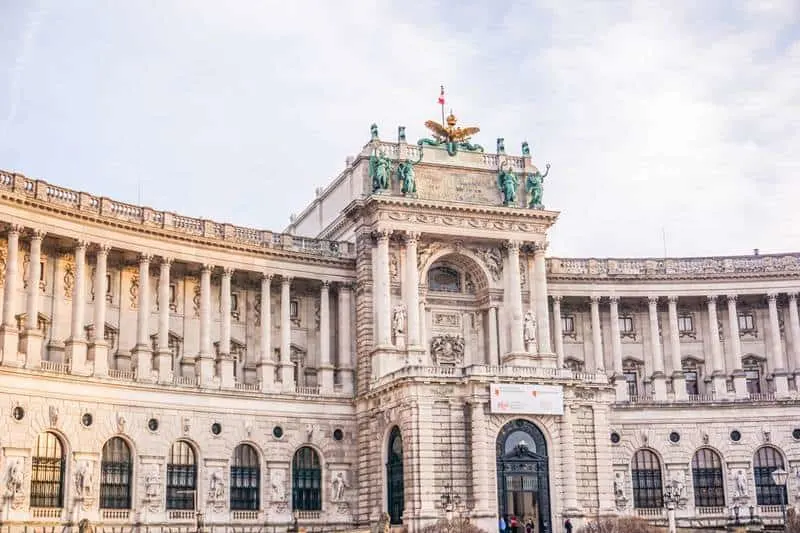
Vienna’s Hofburg Palace.
If you had more time than us, you may like to take a horse drawn carriage (fiaker) trip from here to other parts of the city. I think this must be a fun thing to do.
It is close to the Natural History and Fine arts Museums so good to combine at the same time.
-
Take a day trip to Bratislava
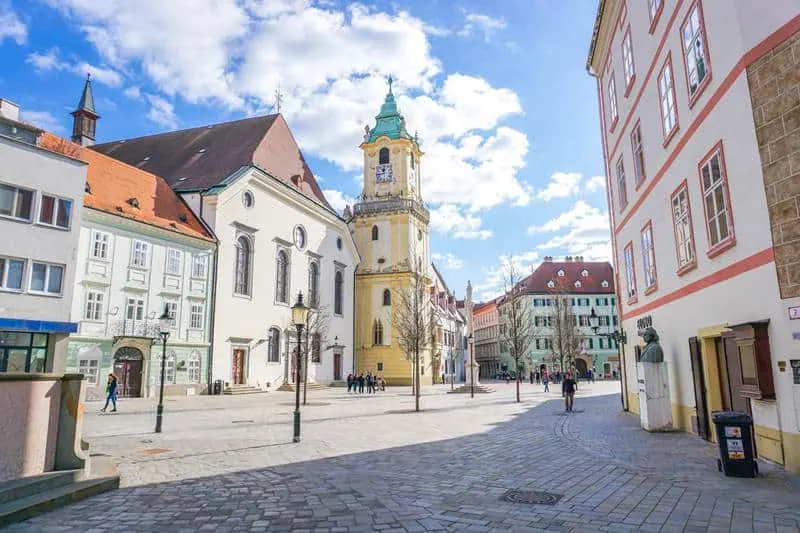
Bratislava Old Town.
Visiting Bratislava, in Slovakia, is one of the best day trips to take from Vienna. The train journey of 1 hour is super comfortable and easy giving you a fantastic opportunity to add another country to your list of visited places!
Bratislava is cheaper than Vienna and quite small too so you can do a lot in one day. Specially when you take advantage of the easy and extremely affordable transport public (a 24 hours ticket is only 3,50 euros!). Get a day card and explore this capital which shares some history with Vienna as it has been under the same Empire in the past.
What to eat and drink in Vienna?
Well obviously the most famous food in Vienna is the Wiener Schnitzel. We all tried one on the first night and yes it was great (pork or chicken). A definite hit with the kids.
Apfelstrudel and sachertorte are also worth trying if you have a sweet tooth. Wiener wurstel (Viennese sausages) are also good to try from street vendors served with some sharp mustard.
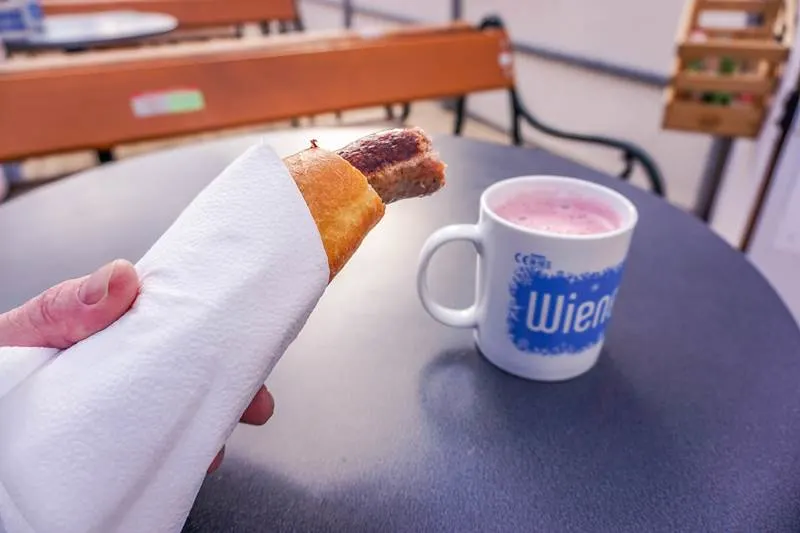
Wiener hot dog and glüwein.
Don’t forget to try Brezel (giant pretzels), they are sold in street stands and bakeries.

Brezels can be plain, savory or sweet.
And we also had to try the Spätzle, a type of pasta made with fresh eggs:

Spätzle is the type of pasta, we saw it served with different ingredients depending on the establishment.
Where to eat? There are so many places to suit different budgets so this definitely depends on where you are, what you like to eat and how much you can spend. Close to our Hotel we tried:
Just be aware if you are an ex-pat like me wanting to watch a 6 nations rugby match in an Irish pub in Vienna – forget it. We went to about 4 different Irish pubs and not one was showing the rugby. It is just not the thing here.
Is Vienna worth visiting?
You will notice as you walk around Vienna that the city is VERY clean. There is no rubbish lying around and no dog mess. In fact there are very few dogs.
If you do see a dog the likelihood is it will be muzzled as that is the rule if you want to take an animal on public transport. I am not sure how they control the mess, but it is very impressive.
Vienna is certainly one of the cleanest cities we have visited and the grandeur and beauty of the architecture and city in general was just a joy to behold. We especially loved the fantastic public transport that gets you from A to B without a single hitch.
We did not have a problem speaking English as most people we spoke to had very good English language skills. We were aware that the population appeared to be very multicultural and civilized.
We did not witness too much begging on the streets or people misbehaving. Judging by the cars and people’s dress the city was clearly quite affluent and well off.
Vienna is a lovely city that has retained its historic past and culture. Visit Vienna, immerse yourself in its culture and enjoy!
